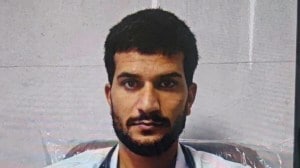Constituent Assembly of J&K, and where it fits into the Article 370 debate
"Negotiations were held in May 1949 on Kashmir’s future set up... Foremost among the topics were the ‘framing of the Constitution for the state (J&K)’ and ‘subjects in respect of which the state should accede to the Union of India’... Nehru wrote to (Sheikh) Abdullah that Patel and he agreed it was a matter for the state’s Constituent Assembly"
 Article 370 was abrogated by the Narendra Modi government in 2019, thus stripping away the special status guaranteed to the erstwhile state of Jammu and Kashmir. (Photo: AP)
Article 370 was abrogated by the Narendra Modi government in 2019, thus stripping away the special status guaranteed to the erstwhile state of Jammu and Kashmir. (Photo: AP) The Supreme Court Wednesday started hearing a batch of petitions challenging the abrogation of Article 370 by the Modi government in 2019, thus stripping away the special status guaranteed to the erstwhile state of Jammu and Kashmir.
Arguing on behalf of the petitioners, senior advocate Kapil Sibal spoke of why the Article is referred to as a “temporary provision”. He said the Constituent makers “envisaged” the formation of the Constituent Assembly of J&K, and it was understood that this Assembly would have the authority to determine the future course of Article 370.
He said: “There was this understanding between the Government of India and the State that we will have a Constituent Assembly which will determine the future course of action, determine whether or not 370 should be abrogated at all or not. That decision was with the Constituent Assembly. Which is why 370 was called a ‘temporary provision’, not for any other reason. So this whole argument that it was temporary – no. The Constitution envisaged a Constituent Assembly which was to decide the fate of Jammu and Kashmir. You had to have the recommendation of the Constituent Assembly before you could efface 370. That’s what the Constitution makers themselves thought in 1950.”
Chief Justice of India D Y Chandrachud, presiding over the five-judge Constitution Bench hearing the petitions, pointed out that Article 370 was placed in Part XXI of the Constitution which deals with “temporary, transitional and special provisions”.
“Temporary are those which are intended to be in existence for a limited period of time but without a point of terminus. Transitional means something which necessarily has a terminus. Third is special… It doesn’t use the expression ‘transitional’ in any headnote or marginal note to the Article. But ‘temporary’ and ‘special’ are used in the marginal notes. And 370 specifically uses the expression temporary… Can we then, by saying that power under Clause 3 (President’s power to abrogate) goes once the Constituent Assembly comes to an end, really convert this into a permanent provision which it was never intended to be by the Constitution?” the CJI asked Sibal.
But why was the Constituent Assembly of J&K formed and what was its role?
J&K acceded to the Indian Union in October 1947, after signing the Instrument of Accession. In his book ‘Article 370: A Constitutional History of Jammu and Kashmir’, constitutional expert and commentator A G Noorani writes that the erstwhile state had acceded to India in respect to only defence, foreign affairs, and communications.
He adds: “Negotiations were held on 15 and 16 May 1949 at Deputy PM Vallabhai Patel’s residence in New Delhi on Kashmir’s future set up. Nehru and (the first Prime Minister or Sadar-i-Riyasat of J and K Sheikh) Abdullah were present. Foremost among the topics were the ‘framing of the Constitution for the state’ and the ‘subjects in respect of which the state should accede to the Union of India’. On the first, Nehru recorded in a letter to Abdullah that both Patel and he agreed that it was a matter for the state’s Constituent Assembly.”
The Constituent Assembly of India, tasked with framing the Indian Constitution, had, in October 1949, introduced draft Article 306A (which was later renumbered as Article 370) in the Constituent Assembly. The Article was discussed for five months between May and October 1949. “Jammu and Kashmir was the only state in the Union of India which negotiated the terms of its membership with the Union,” writes Noorani.
Clause 370(3) reads: “Notwithstanding anything in the foregoing provisions of this Article, the President may, by public notification, declare that this Article shall cease to be operative or shall be operative only with such exceptions and modifications and from such date as he may specify: Provided that the recommendation of the Constituent Assembly of the State referred to in Clause (2) shall be necessary before the President issues such a notification.”
Noorani writes further that on April 20, 1951, a proclamation was made for convening the state’s Constituent Assembly. “Two issues came to the fore. Nehru was eager to secure Kashmir’s ‘closer integration’ to India. The Sheikh was as eager to preserve its autonomy,” writes Noorani.
It was decided that the J&K Constituent Assembly would consist of representatives of the people, elected on the basis of adult franchise, and would help frame a constitution for the state.
For the purpose of election to the Constituent Assembly, the state was divided into territorial constituencies, each containing a population of 40,000, with each electing one member.
An article from the Constitution of India database, an initiative bythe Centre for Law and Policy Research, Bangalore, notes that the elections for the same were held in August-September 1951. The National Conference led by Sheikh Abdullah swept them. All 75 members were from the party.
The article adds that the J&K Constituent Assembly largely adopted procedures similar to the Indian Constituent Assembly, with smaller groups of Assembly members constituted into committees and tasked with producing draft Articles on specific themes. The reports of these committees containing draft Articles were presented to the plenary Assembly for debate and amendments. The Assembly then adopted or rejected the Articles via vote.
The J&K Constituent Assembly first met on October 31, 1951.
Noorani’s book notes that in their early sessions, the committees deliberated on the whether the state would be based on the principles of democracy or constitutional monarchy (considering it was a princely state), and on a flag for the state.
He quotes an interim report of the Basic Principles Committee of the J&K Constituent Assembly from June 10, 1952, which said: “The monarchy was a relic of a feudal system which was based on mass exploitation of the resources of the country and the labour of its people for the self aggrandisement of an individual and a limited class of his associates. The form of the future Constitution of Jammu and Kashmir shall be wholly democratic. The institution of hereditary rulership shall be terminated and the Office of the Head of the State shall be elective.”
Noorani also quotes a white paper of the Government of J&K on the Delhi Agreement of 1952 entitled ‘India and Kashmir – Constitutional Aspect’. It noted, “The main functions which the Constituent Assembly was envisaged was the question of the accession of the state; retention or abolition of the Ruler as the Constitutional Head of the State; the question of framing a Constitution for the state, including the question of defining the Union sphere of jurisdiction over the state; and the question of awarding compensation to the landlords whose lands had been expropriated under the Big Landed Estates Abolition Act.”
On the nature of Article 370, Noorani quotes Abdullah’s statement on the Delhi agreement from a J&K Constituent Assembly debate dated August 11, 1952. “I would like to point out that the fact that Article 370 has been mentioned as a temporary provision in the Constitution does not mean that it is capable of abrogated, modified, or replaced unilaterally. In actual effect, the temporary nature of this Article arises merely from the fact that the power to finalise the constitutional relationship between the State and the Union of India has been specifically vested in the Jammu and Kashmir Constituent Assembly,” said Abdullah.
On August 9, 1953, the police arrested Sheikh Abdullah, and dismissed his government on the charge that he had lost the confidence of his Cabinet. Bakshi Ghulam Mohammed took over as Sadar-e-Riyasat in his place.
The Constitution of J&K was adopted in 1956.
Sheikh Abdullah spent most of his time in detention till his release in 1964, to a rapturous welcome.



- 01
- 02
- 03
- 04
- 05




























